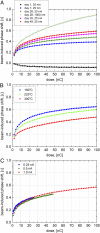Volta potential phase plate for in-focus phase contrast transmission electron microscopy
- PMID: 25331897
- PMCID: PMC4226124
- DOI: 10.1073/pnas.1418377111
Volta potential phase plate for in-focus phase contrast transmission electron microscopy
Abstract
We describe a phase plate for transmission electron microscopy taking advantage of a hitherto-unknown phenomenon, namely a beam-induced Volta potential on the surface of a continuous thin film. The Volta potential is negative, indicating that it is not caused by beam-induced electrostatic charging. The film must be heated to ∼ 200 °C to prevent contamination and enable the Volta potential effect. The phase shift is created "on the fly" by the central diffraction beam eliminating the need for precise phase plate alignment. Images acquired with the Volta phase plate (VPP) show higher contrast and unlike Zernike phase plate images no fringing artifacts. Following installation into the microscope, the VPP has an initial settling time of about a week after which the phase shift behavior becomes stable. The VPP has a long service life and has been used for more than 6 mo without noticeable degradation in performance. The mechanism underlying the VPP is the same as the one responsible for the degradation over time of the performance of thin-film Zernike phase plates, but in the VPP it is used in a constructive way. The exact physics and/or chemistry behind the process causing the Volta potential are not fully understood, but experimental evidence suggests that radiation-induced surface modification combined with a chemical equilibrium between the surface and residual gases in the vacuum play an important role.
Keywords: TEM; Volta potential; cryo-EM; phase contrast; phase plate.
Conflict of interest statement
Conflict of interest statement: B.B. is a full-time employee of FEI.
Figures






References
-
- Danev R, Nagayama K. Transmission electron microscopy with Zernike phase plate. Ultramicroscopy. 2001;88(4):243–252. - PubMed
-
- Walter A, et al. Practical aspects of Boersch phase contrast electron microscopy of biological specimens. Ultramicroscopy. 2012;116:62–72. - PubMed
-
- Frindt N, et al. In-focus electrostatic Zach phase plate imaging for transmission electron microscopy with tunable phase contrast of frozen hydrated biological samples. Microsc Microanal Canada. 2014;20(1):175–183. - PubMed
-
- Edgcombe CJ, et al. Characterisation of ferromagnetic rings for Zernike phase plates using the Aharonov-Bohm effect. Ultramicroscopy. 2012;120:78–85. - PubMed
Publication types
LinkOut - more resources
Full Text Sources
Other Literature Sources

